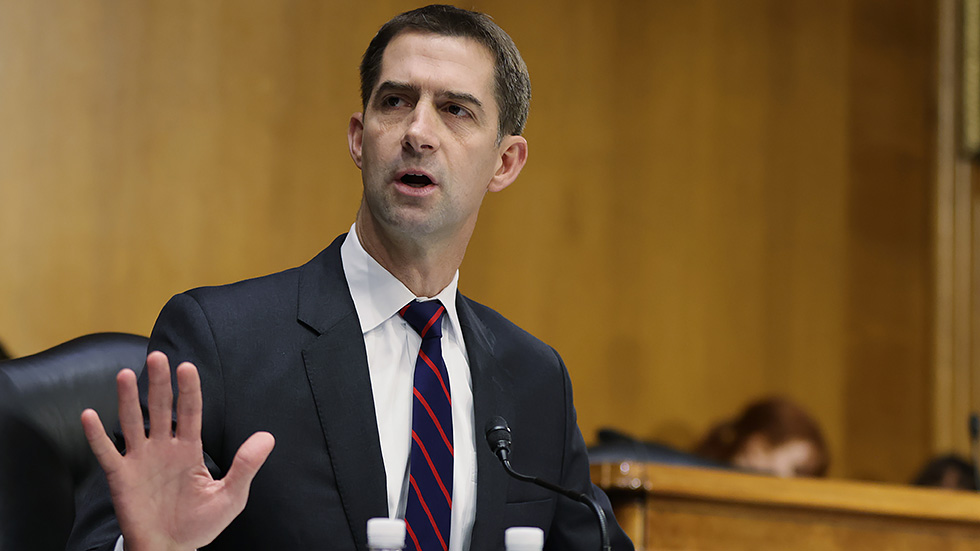Overnight Defense & National Security — Senators grill Biden officials on Ukraine
It’s Thursday, welcome to Overnight Defense & National Security, your nightly guide to the latest developments at the Pentagon, on Capitol Hill and beyond. Subscribe here: digital-stage.thehill.com/newsletter-signup.
Senators on Thursday grilled the Biden administration’s top intelligence officials on a wide range of issues regarding Russia’s attack on Ukraine.
We’ll share the most pressing topics and what the officials said, plus new details on North Korea’s latest missile launches and the findings of a just-wrapped investigation into a deadly 2020 terror attack on U.S. forces in Kenya.
For The Hill, I’m Ellen Mitchell. Write me with tips at emitchell@digital-stage.thehill.com.
Let’s get to it.
Russia chemical attack fears dominate

Senators on Thursday pressed intelligence officials over the U.S. response to Russian President Vladimir Putin’s invasion of Ukraine as fears mount that Moscow is preparing a chemical weapons attack and risking a nuclear conflict.
Lawmakers further grilled intelligence officials over what steps the U.S. can take to deter Putin, including increasing American military and air assistance to help Ukrainians repel Russian forces amid increasing civilian casualties.
Information as a weapon: CIA Director William Burns said intelligence leaders “take very seriously” the threat of a chemical weapons attack in Ukraine and said the decision to declassify and release intelligence previewing Putin’s likely moves has served to deter action and unify a global response.
“I am convinced that our efforts at selective declassification to preempt those kind of false flag efforts and the creation of false narratives have been so important,” Burns said, speaking during an annual hearing of the Senate Intelligence Committee worldwide threats hearing.
“This is one information war that I think Putin is losing.”
A false narrative: Russian officials, amplified by state-backed media, are pushing a narrative — roundly rejected by U.S. officials — that biomedical research labs in Ukraine supported by the U.S. are part of a more sinister plot surrounding dangerous weapons development.
“Let me be clear, we do not assess that Ukraine is pursuing either biological weapons or nuclear weapons, which have been some of the propaganda that Russia is putting out,” Director of National Intelligence Avril Haines told lawmakers.
Concerning warnings: Haines added that the intelligence community is “very concerned” and is monitoring “everything that may be going on with respect to Russia’s strategic nuclear forces” but had not assessed any significant changes that would indicate potential use of nuclear weapons.
“It’s nothing unprecedented,” she said of what they are observing.
The White House has said that Putin’s warnings about Ukrainian biological weapons may in fact be a signal that Russia may deploy such weapons of mass destruction, as it has done in previous conflicts.
Senators grill intel chiefs over fighter jets

Also at the hearing, Republican senators grilled intelligence officials for not supporting Poland’s plan to send fighter jets to Ukraine, claiming the United States was bowing to threats from Russian President Vladimir Putin.
Sen. Tom Cotton (R-Ark.) blasted U.S. officials for “failing to help Poland,” which on Tuesday offered to send MiG-29 fighter jets to a base in Germany for deployment to Ukraine, with the U.S. then providing fighter jets to Poland to resupply its military.
The White House ultimately rejected that proposal, warning it could be viewed as an escalatory action in Putin’s eyes that could trigger a larger conflict between NATO and Russia.
An ‘escalation ladder’: Lt. Gen. Scott Berrier, director of the Defense Intelligence Agency, repeated to lawmakers Thursday that there was an “escalation ladder” and Putin would view the transfer of fighter jets to Ukraine as an escalation.
Director of National Intelligence Avril Haines told the committee the decision to nix the transfer of the fighter jets was also based on the perception of Putin.
“It’s whether or not they perceive us as being in conflict with them,” Haines said. “We’re in a very challenging position right now where we are obviously providing enormous amounts of support to Ukraine … but at the same time, trying not to escalate the conflict into a full-on NATO or U.S. war with Russia.”
Read the rest of the story here.
US: N. Korea launches a ‘serious escalation’

North Korea tested a “relatively new” intercontinental ballistic missile system in February and earlier this month, a senior Biden administration official said Thursday, describing the tests as a “serious escalation” by Pyongyang which last tested such a missile in 2017.
“After careful analysis, the U.S. government has concluded that the DPRK’s two ballistic missile tests on Feb. 26 and March 4 of this year involved a relatively new intercontinental ballistic missile system that the DPRK is developing,” the official told reporters on Thursday, referring to North Korea by its official name.
A ‘serious escalation’: “This is a serious escalation by the DPRK, but unlike the DPRK’s three ICBM tests in 2017, neither of these launches demonstrated ICBM range or capability,” the official said.
Previously: South Korea’s military previously reported the missile tests as they happened. In both cases, South Korea said the missiles were launched into the sea and flew less than 200 miles while reaching altitudes of less than 400 miles.
A new system: The Biden administration believes that the launches were meant to test elements of the new system before a full-range launch is conducted, the senior official said Thursday, warning that North Korea could disguise a future launch as a space launch.
The US response: In response to the missile tests, the Treasury Department is expected to announce new actions on Friday that would prevent North Korea from obtaining foreign technologies to advance its weapons program.
The U.S. Indo-Pacific Command also said earlier this week it was ordering intensified intelligence, surveillance and reconnaissance activities in the Yellow Sea and “enhanced readiness” of ballistic missile defense forces in the Indo-Pacific in response to recent North Korean ballistic missile launches.
SIGN UP NOW
⏱ Don’t miss a beat! Get on the list for NotedDC, The Hill’s new insider take on the heartbeat of politics and policy, coming soon.
Probe: Multiple failures led to deadly attack

Faults in intelligence-sharing, security and leadership paved the way for the deadly attack on Kenyan airbase used by U.S. troops in January 2020, a new Pentagon investigation finds, though the probe points to no single shortcoming.
An investigation by U.S. Africa Command (Africom) and a separate independent review found that on Jan. 5, 2020 a well-prepared, “ruthless and determined enemy force” of 30 to 40 al-Shabab militants conducted the attack against U.S. forces and assets at Manda Bay, officials said.
A few short minutes after the attack began, U.S. Army Spc. Henry Mayfield and two U.S. contractors, Bruce Triplett and Dustin Harrison, were killed, while six contractor-operated civilian aircraft were damaged in the incident.
The issues: “We were not as prepared at Manda Bay as we needed to be,” Africom head Gen. Stephen Townsend said via video at the Pentagon.
Townsend said the investigation found four factors that contributed to the deadly outcome, including “inadequate focus on potential threats,” shortcomings in intelligence-sharing, deficiencies in preparing security forces in charge of guarding the base and poor command unity.
“Certain senior officers contributed to the inadequate force protection posture at Mandalay Bay, and to some extent, allowed a climate of complacency and poor understanding of the threat,” said Air Force Maj. Gen. Tom Wilcox, who assisted in the independent review.
How it unfolded: On Thursday, multiple defense officials detailed the attack’s timeline of events, which began when two U.S. service members, Mayfield and a colleague, were driving a truck to clear the base’s runway when they saw thermal images of what was first thought to be hyenas. The two realized too late they had instead identified al-Shabab fighters hiding in the vegetation, officials said.
Mayfield was killed after a rocket-propelled grenade hit the vehicle and exploded, though his colleague was able to escape.
The two defense contractors, Triplett and Harrison, were killed when militants attacked their plane that was taking off and it caught fire.
The significance: The attack on the base, situated on the coast and near the Somali border, was largely overshadowed at the time as it came two days after the U.S. drone strike ordered by then-President Trump that killed top Iranian Gen. Qassem Soleimani.
But the incident marked the most U.S. military-related deaths in Africa since the October 2017 ambush in Niger where four soldiers were killed.
ON TAP FOR TOMORROW
- U.S. Ambassador to NATO Julianne Smith will speak at a Washington Post Live event on “World Stage: Ukraine,” at 11 a.m.
- The Homeland Security and Defense Forum will hold an event on “Celebrating Women in Homeland Security,” at 12 p.m.
- The Institute for Corean-American Studies will hold its virtual winter symposium on “The Ukraine Crisis, Indo-Pacific, Northeast Asia and U.S. National Security,” at 7 p.m.
WHAT WE’RE READING
- Military commanders asking Biden to station commandos in Somalia: report
- China is wildcard in Russia-Ukraine war
- UK ‘very concerned’ Russia may use chemical weapons, says British foreign secretary
- Russia has lost nearly as many soldiers in Ukraine as US has in Iraq/Afghanistan since 2001
- Islamic State names new leader
- US intel head rejects Russia’s claims about Ukraine biolabs
- Court rulings add pressure on Biden to end Trump-era border policy
- More than 200 Capitol rioters have pleaded guilty 14 months after attack, DOJ says
- The Hill: Opinion: Putin’s war exposes the cracks in the world order — can we fix them?
That’s it for today! Check out The Hill’s defense and national security pages for the latest coverage. See you Friday.
Copyright 2023 Nexstar Media Inc. All rights reserved. This material may not be published, broadcast, rewritten, or redistributed. Regular the hill posts
Video/Hill.TV














